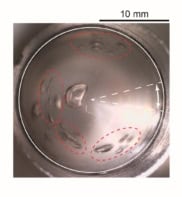Fresh groundwater is less abundant in the US than previously thought, with some regions having reserves that extend less than 300 m deep, an analysis has shown.
In the south-west US, fresh groundwater extends to more than 1000 metres below ground, whereas in certain regions of the east, and in the semi-arid High Plains of the central US, fresh supplies range to just tens of metres deep, potentially threatening future agriculture, the analysis shows.
On average, the transition from freshwater to deeper brackish water occurs at about 550 metres, but according to Grant Ferguson of the University of Saskatchewan in Canada, that is still far less than the 1000–2000 m typically assumed.
“Deep groundwater is a strategic resource that can be used to mitigate water scarcity over short time periods,” he says. “However, we need better management strategies to ensure that this is possible.”
Satellites such as GRACE – a joint mission of NASA and the German Aerospace Centre – have shown that supplies of fresh groundwater are being depleted by several centimetres a year in key aquifers.
What is less certain is how deep the supplies go. Even when the water begins to turn brackish – that is, slightly salty – at depth, it is still a potential resource, because technological processes such as reverse osmosis can extract its salt.
The future situation is murky, however, because underground pore spaces containing brackish water can also be exploited for potentially contaminating activities such as hydraulic fracturing and enhanced oil recovery. In 2016, scientists at Stanford University, US, reported evidence of groundwater contamination by hydraulic fracturing beneath the small town of Pavillion, Wyoming.
Ferguson – together with Jennifer McIntosh of the University of Arizona and Debra Perrone and Scott Jasechko of the University of California, Santa Barbara –attempted to bring more clarity to US groundwater supplies by quantifying the depths at which aquifer systems transition from fresh to brackish, and where oil and gas activities are widespread.
The team collected data on the water chemistry of sedimentary basins from the US Geological Survey, determined the extent of fresh and brackish groundwater, and compared the figures with the depths of water wells, using data from other government agencies. The researchers also compared their findings with the depths of injection wells installed in aquifers exempted from the US Safe Water Drinking Act, and oil- and gas-production wells.
The results were varied, with the deepest fresh supplies in the west and south, although some regions of the west, such as Wyoming and Montana, also showed evidence of oil-and-gas activities close to shallow freshwater.
“In the US south-west, fresh water is quite extensive at depth,” says Ferguson. “This has allowed the drilling of deeper and deeper wells to address water scarcity, at least in the short term.”
The shallowest supplies are in the centre and east of the US, according to the study. People in the US High Plains “will not be able to drill their way out of water scarcity,” says Ferguson, “and this could have dire consequences for agriculture in this area.”



